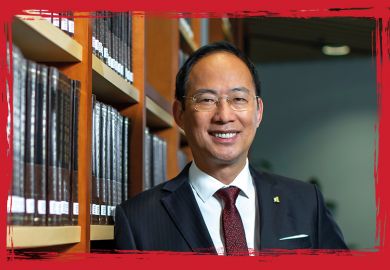View the THE Latin America University Rankings 2023 results
Each morning, Jorge Grünberg, rector of the technology-focused university ORT Uruguay, begins his day by flipping through Uruguay’s national newspaper. He often stumbles across familiar names.
Take a recent article about a young entrepreneur – a biotech engineer and ORT alumna – who, since graduating, has founded her own company to find new ways of treating chronic inflammation diseases. Hers is just one of dozens of success stories that he believes illustrate his university’s contribution to the country and Latin America.
Located in Uruguay’s capital city of Montevideo, ORT is a private institution. It scores in the 151+ band in Times Higher Education’s Latin America University Rankings 2023 – and is the only university in the country to be featured in the league table.
Innovation runs in the university’s veins. ORT’s Centre for Innovation and Entrepreneurship runs an incubator for companies and teaches students how to launch their own businesses, assess ideas and secure start-up capital. Students are encouraged to take “an entrepreneurial attitude”, based on the belief that youth is the time for risk-taking and experimentation.
Latin America University Rankings 2023: results announced
While that may seem like the standard modus operandi for Silicon Valley, in Latin America’s risk-averse society, ORT breaks the mould, according to Grünberg.
“When we promote this we are being, in a way, counter-cultural,” he says.
It’s something Grünberg is familiar with, having done his degree in computer engineering back in the 1970s, when it was considered “exotic” in his country.
He believes Uruguay and Latin America have “a general problem with entrepreneurship”. Instead, the culture leans toward securing a place as an employee, especially one that works for the state, he says. That couldn’t be more different from ORT’s approach.
In November last year, Bloomberg News described the university as “a cradle for unicorns” after the country’s first three “unicorns” – companies to receive a $1 billion (£800 million) valuation – were born out of the university, one of them incubated in its entrepreneurship centre and the other two launched by ORT alumni.
An average of 10 companies a year now grow out of the institution, Grünberg says. The process often begins in students’ final year of study, when they are nudged to think about their projects or dissertations as business plans. They pitch these ideas to the incubation centre; the best ones are picked. The university then helps the students get in touch with investors and can often secure seed funding in the region of $30,000 to $40,000.
The resulting companies are more than business success stories, Grünberg believes. For ORT’s graduates, they’re a way up. The university’s focus on technical education in engineering, computers and design makes it a vehicle for social mobility.
More than 10,000 students strong, it produces programmers, web designers, data analysts and cyber-security specialists, feeding into a job market where digital and quantitative jobs are in great demand. ORT’s graduates are highly sought after, with an employment rate of 97 per cent after graduation.
In part, it has tapped into an unmet need in the country – one that the government in Montevideo recognises. In early 2023, responding to an IT-worker deficit and a brain drain in the industry, Uruguayan policymakers proposed a system of tax benefits to attract IT professionals and companies.
“The story of our graduates is very heartening for us,” says Grünberg. Students from the lower middle class, he says, often the children of taxi drivers or cleaners, have finished university to become the highest-earning members of their families when they graduate.
“The pyramid of income in the family goes upside down,” he says. Even in their early 20s, alumni are able to help their parents with rent, buy them bigger houses or even move them to better neighbourhoods.
“This sort of mobility, leveraged by education and job opportunity, that’s what we are all about,” he says of the institution.
It can also help learners to find a way around the trappings of class division.
“When we bring them to ORT and give them the opportunity to study and connect them with companies, we are basically providing them with a safe route out of crime. And out of the illusion of elite football, which is only for a few,” says Grünberg.
Uruguay’s higher education system comprises six universities – two public and four private ones, including ORT. Public education is free and accounts for the majority of students. Grünberg says that despite this, ORT’s student body is not very different from that of its state-funded counterparts. This is because two thirds of students are on some form of scholarship. Scholarships and salaries, he says, make up the bulk of the university budget; further funding is raised through private donations. Grünberg adds that students also find the return on their investment in a technical education degree “gets repaid very quickly”.
However, “a terrible truth” persists for education in Uruguay, according to the rector. The country’s universities – both public and private – have remained a place for the middle class. Those who are extremely poor rarely finish high school, let alone higher education.
In the wider context of Latin America, Uruguay has the least inequality. The country, which is one third the size of France, “stands out in Latin America for being an egalitarian society and for its high income per capita”, according to the World Bank.
Grünberg attributes this to the government’s investment in building schools and making basic education free in the early decades of the 20th century, which meant that there was a “minimum level of education that excluded extremes”. Compared with its neighbours, Uruguay has a smaller gap between the very rich and the very poor. As of 2022, the World Bank reported that 60 per cent of the population was middle class – the largest in America, in relative terms.
Currently, its major challenge is raising education levels for the technological age, Grünberg says.
“If you know how to read and write, it’s not enough. Now you need more. You need a degree [from a] university. You need continual education through your life. You need to speak English. You need a lot of things that were not considered in the first social contract of Uruguay in the first decades of the 20th century.”
Adult literacy levels stand at 99 per cent, according to Unesco data.
“Uruguay is now trying to find out how to face this new challenge of going to the next step – from being literate in the sense of the 20th century to becoming literate in the sense of the 21st century,” Grünberg says.
Already a tourist hub, it has the potential – and plenty of ready infrastructure – to become an education hub for Latin America, he believes. Outside the busy holiday season from December to February, thousands of apartments lie vacant. “Students could use all this infrastructure that gathers dust, nine or ten months a year,” he says.
As the country’s institutions gain repute, Grünberg hopes learners from the broader region, including Mexico, Columbia and Peru, will consider moving to his country for graduate and postgraduate studies, making it a popular destination for overseas learners.
“University education could really be an export industry for Uruguay. It could be like Australia,” he says.
Register to continue
Why register?
- Registration is free and only takes a moment
- Once registered, you can read 3 articles a month
- Sign up for our newsletter
Subscribe
Or subscribe for unlimited access to:
- Unlimited access to news, views, insights & reviews
- Digital editions
- Digital access to THE’s university and college rankings analysis
Already registered or a current subscriber? Login








